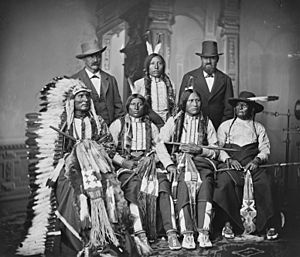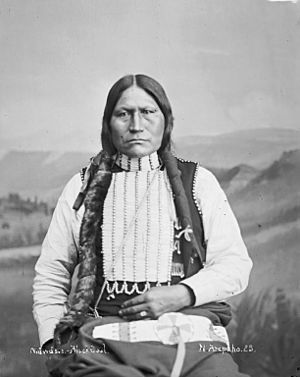Chief Black Coal facts for kids
Wo’óoseinee’, usually called Black Coal, was a very important leader of the Northern Arapaho people. He lived from about 1840 to 1893. During the late 1800s, he helped his people change from a life of moving freely and sometimes fighting against American expansion. Instead, he guided them towards making alliances and eventually settling down. He worked as a go-between, or intermediary, for the Northern Arapaho and the United States government. He helped his people find a permanent home alongside the Eastern Shoshone on what is now the Wind River Indian Reservation.
Contents
Becoming a Leader
Black Coal's name, Wo’óoseinee’, comes from a story. It says he rolled in black ashes after winning a fight. It does not mean he was named after the fossil fuel, coal. He became well-known in the 1860s because of his brave actions in battles. These battles took place in the Powder River Country. During this time, the Arapaho often teamed up with the Lakota and Cheyenne tribes.
Black Coal fought in important battles like the Battle of Platte Bridge in July 1865. This was where Caspar Collins was killed. He also fought in the attack on Fort Phil Kearney in December 1866.
In 1865, soldiers attacked Northern Arapaho leader Black Bear's camp at the Battle of the Tongue River. About 500 people were there, and 35 warriors died. After this, the Arapaho found it harder to gather large groups for war. By the late 1860s, the Arapaho decided that making alliances and talking things out was a better path than fighting.
Starting in 1868, Arapaho people often joined the U.S. Army as scouts. Black Coal played a big part in this peaceful approach. He worked hard to keep the Arapaho out of fights with the United States and the Shoshone people. At first, other chiefs like Black Bear and Medicine Man (also known as Sorrel Horse) were more important. But after they died in 1870 and 1871, Black Coal became the main leader of the Antelopes, called nischéhiinenno. This was the largest group of Northern Arapahoes.
Arapaho Leadership Style
Historian Loretta Fowler explains that Northern Arapaho leaders in the 1860s and 1870s did not simply give orders. Instead, the tribe chose their leaders by agreeing together. The "Water Pouring Old Men," who were ceremonial leaders, also had to approve. These elders held the highest authority.
In this system, intermediary chiefs like Black Coal were expected to act as messengers. They had to speak strongly for Arapaho interests. They also had to share what the tribe had agreed upon with outsiders. These outsiders included U.S. Army generals, government officials, and diplomats. This way of leading helped the Arapaho keep their own power and leadership structures. It also protected the ceremonial elders from having to deal directly with the United States.
The United States government often wanted to pick one "head chief" who could speak for everyone in the tribe. From 1871, U.S. officials saw Black Coal as the main Northern Arapaho chief. However, he only had the power to speak what the tribe had already agreed upon. Chief Sharp Nose was seen as the second-ranking chief by the government until Black Coal died in 1893. In reality, Black Coal and Sharp Nose usually shared the same ideas for their different groups of people.
Black Coal as an Intermediary Chief

Black Coal, along with Black Bear and Sorrel Horse, signed the Treaty of Fort Laramie (1868). This treaty gave them the right to hunt north of the Platte River as long as there was game. For the next few years, Black Coal would sometimes stay near Red Cloud Agency or Fort Fetterman to get supplies. Other times, he would lead his group on hunting trips.
In 1874, Black Coal refused to join the Lakotas and Cheyennes in attacking the Shoshone in the Wind River Basin. The U.S. Army was ready to fight the Shoshone's enemies. Using two Shoshone scouts, they found and attacked Black Coal's camp. This camp had up to 112 lodges and 600-700 people. The attack happened on Bates Creek in the Bridger Mountains (Wyoming).
The fight at Bates Battlefield resulted in the deaths of 18 to 34 Arapahoes. Black Coal's horse was shot from under him. After losing many people, the Arapaho climbed a bluff. They fired heavily from behind limestone boulders, forcing the soldiers and Shoshones to leave. After this battle, some Arapahoes went south for several years, even as far as Oklahoma. Black Coal moved to Pumpkin Butte and then to Red Cloud Agency.
In 1876, the U.S. Army began the Great Sioux War by attacking the Cheyenne. On March 1, Black Coal's group headed south to Fort Fetterman. This showed they wanted peace. Black Coal joined the U.S. Army as a scout during this time. He hoped this would give him more respect within his tribe. It also meant he would get supplies, Army pay, and hopefully help from U.S. Army officials. He wanted their support to get a permanent reservation for the Northern Arapaho. Sharp Nose, another Northern Arapaho leader, was chief of the Arapaho Scouts. He served with Colonel Ranald S. Mackenzie at the Dull Knife Fight on November 25, 1876. This battle broke the resistance of the Northern Cheyenne.
Black Coal wanted a permanent home for the Arapaho. In 1876, he visited the Southern Arapaho Reservation in Oklahoma. But he did not like the location. In 1877, Black Coal, along with Sharp Nose and interpreter Friday, traveled to Washington D.C. They were part of a group that met President Rutherford B. Hayes. Their goal was to find a permanent home for the Arapaho that was not along the Missouri River or in Oklahoma. Black Coal described Oklahoma as "sickly." Black Coal's speeches from this trip showed how good he was at convincing people. He argued that the Arapaho would gladly farm and take part in other "civilizing" programs if they received "good land" for farming. Within months, the United States asked the Shoshones for permission to settle the Arapahoes on the Sweetwater River, south of the Shoshone agency.
The Northern Arapaho were later moved to the Shoshone reservation. This was so they could be closer to the agency where they received supplies. For the rest of his life, Black Coal worked to make this arrangement official. He wanted to make sure the Arapaho had the right to live on Wind River.
Settling on the Wind River Reservation
Black Coal was the leader of the Antelope Band of Northern Arapahoes, which had about 700 people. They mostly settled near where the Wind River and Popo Agie River meet. Because of this, other members of the tribe called them the "Forks of the River People," or nóonó'owú'unénno. Today, this community is known as "Arapahoe." It is located near the St. Stephens Mission and the city of Riverton, Wyoming. Black Coal became Catholic and supported missionary efforts.
Sharp Nose's group settled near what is now the village of Ethete. Friday's group settled on Trout Creek.
Death and Legacy
Black Coal died on July 10, 1893, at the age of 53. He was buried on the bluffs west of St. Stephen's Mission. A monument at his grave says, "Erected by the Northern Arapahoes in honor of a brave and honest man."
Return of Black Coal's Headdress
In December 2019, a retired professor named Temple Smith contacted the Black Coal Senior Center and the Northern Arapaho Tribal Historic Preservation Office. He wanted to return Black Coal's headdress to the Northern Arapaho people. Smith's great-grandfather was a dentist in Buffalo, Wyoming. He had traveled to the Wind River area in the 1870s or 1880s. There, he had done dental work on Black Coal's teeth. The chief gave the dentist an eagle feather headdress as a thank you gift.
The Smith family kept the headdress for over a hundred years, storing it in their attic. In January 2020, a group from the Northern Arapaho arrived to bring the headdress back home. After driving the headdress back to Wyoming, it was treated at the University of Wyoming Archaeological Repository. This process used freezing to kill any insects or germs.
A special "cedaring ceremony" was held at the Native American Center on the University of Wyoming Campus on January 27, 2020. During this ceremony, Northern Arapaho Council Member Sam Dresser prayed over the headdress. It was "cedared" in the four directions, which is a traditional blessing. This prepared the headdress for its final return to the Wind River Indian Reservation.


